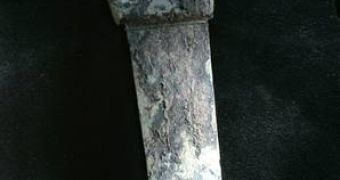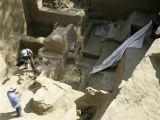Archaeologists have unearthed 22 tombs at 33 feet (10 m) depth in northern Peru containing a trove of Sican (a pre-Inca civilization) artifacts and, for the first time, scientists unearth "tumi" ceremonial knives, with figurine handles and arched-shaped blades, on their original archaeological setting, not recovered from tomb looters.
This way, scientists can understand the context in which the tumi, Peru's national symbol, was used. "This discovery comes as an important contribution to know the burial rites of the elite of this culture," said prominent archaeologist Walter Alva. The grave, more than 900 years old, were discovered next to a pyramid in the Pomac Forest Historical Sanctuary, 420 miles (700 km) northwest of the capital, Lima.
Sican culture descended from Moche culture and flourished in Peru's northern desert coast between 750 and 1375, when warfare and prolonged drought destroyed their civilization. Those buried there "are clearly from the social elite and therefore some of them have gold objects, some of them have copper-gilded objects, but they are quite complex, well-endowed tombs," said Izumi Shimada, an anthropology professor at Southern Illinois University.
Since July, 10 tumi knives were discovered, including a 14-inch copper alloy tumi bearing the image of the Sican deity. "The tumi has for many years been the symbol of Peru, and yet no decorated tumi has ever been found or documented scientifically," sais Shimada.
"All known tumi knives were looted by grave robbers." As Sican artifacts were always described out of context, many times they were misidentified as belonging to Inca Empire, which appeared later, and are not related to Sicans. "It is the first time that such a tumi has been found in context, in a scientific manner, and therefore we will be able to speak a lot about the cultural significance of this object," he said.
"Finally, archaeologists have the opportunity to show a scientifically excavated tomb where the context can be known for these objects," said Alva.
In the late '80s Alva led archaeological diggings on the famous archeological Lords of Sipan tombs. "One grave contains the remains of a woman about 25 years old buried with 120 miniature clay "crisoles" or crucibles", said Shimada.
The archaeologists suppose they were made by each individual present at the funeral ceremony "as a sort of last offering to be placed in the burial chamber."
Photo credit: Martin Mejia/AP

 14 DAY TRIAL //
14 DAY TRIAL // 
